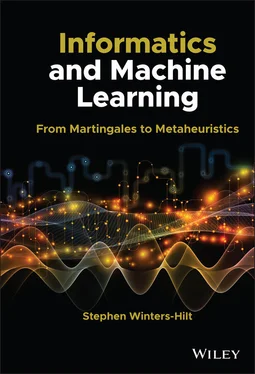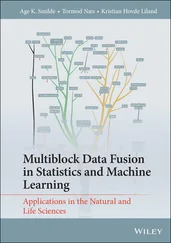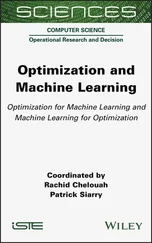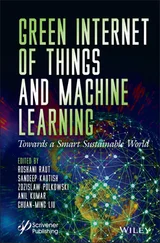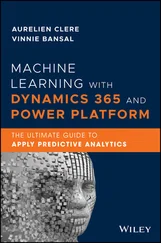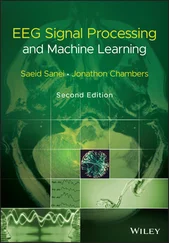Stephen Winters-Hilt - Informatics and Machine Learning
Здесь есть возможность читать онлайн «Stephen Winters-Hilt - Informatics and Machine Learning» — ознакомительный отрывок электронной книги совершенно бесплатно, а после прочтения отрывка купить полную версию. В некоторых случаях можно слушать аудио, скачать через торрент в формате fb2 и присутствует краткое содержание. Жанр: unrecognised, на английском языке. Описание произведения, (предисловие) а так же отзывы посетителей доступны на портале библиотеки ЛибКат.
- Название:Informatics and Machine Learning
- Автор:
- Жанр:
- Год:неизвестен
- ISBN:нет данных
- Рейтинг книги:3 / 5. Голосов: 1
-
Избранное:Добавить в избранное
- Отзывы:
-
Ваша оценка:
- 60
- 1
- 2
- 3
- 4
- 5
Informatics and Machine Learning: краткое содержание, описание и аннотация
Предлагаем к чтению аннотацию, описание, краткое содержание или предисловие (зависит от того, что написал сам автор книги «Informatics and Machine Learning»). Если вы не нашли необходимую информацию о книге — напишите в комментариях, мы постараемся отыскать её.
Discover a thorough exploration of how to use computational, algorithmic, statistical, and informatics methods to analyze digital data Informatics and Machine Learning: From Martingales to Metaheuristics
ad hoc, ab initio
Informatics and Machine Learning: From Martingales to Metaheuristics
Informatics and Machine Learning — читать онлайн ознакомительный отрывок
Ниже представлен текст книги, разбитый по страницам. Система сохранения места последней прочитанной страницы, позволяет с удобством читать онлайн бесплатно книгу «Informatics and Machine Learning», без необходимости каждый раз заново искать на чём Вы остановились. Поставьте закладку, и сможете в любой момент перейти на страницу, на которой закончили чтение.
Интервал:
Закладка:
From Martingales to Metaheuristics
Stephen Winters‐Hilt
Meta Logos Systems
Albuquerque, NM, USA

This edition first published 2022
© 2022 John Wiley and Sons, Inc.
All rights reserved. No part of this publication may be reproduced, stored in a retrieval system, or transmitted, in any form or by any means, electronic, mechanical, photocopying, recording or otherwise, except as permitted by law. Advice on how to obtain permission to reuse material from this title is available at http://www.wiley.com/go/permissions.
The right of Stephen Winters‐Hilt to be identified as the author of this work has been asserted in accordance with law.
Registered Office John Wiley & Sons, Inc., 111 River Street, Hoboken, NJ 07030, USA
Editorial Office 111 River Street, Hoboken, NJ 07030, USA
For details of our global editorial offices, customer services, and more information about Wiley products visit us at www.wiley.com.
Wiley also publishes its books in a variety of electronic formats and by print‐on‐demand. Some content that appears in standard print versions of this book may not be available in other formats.
Limit of Liability/Disclaimer of Warranty The contents of this work are intended to further general scientific research, understanding, and discussion only and are not intended and should not be relied upon as recommending or promoting scientific method, diagnosis, or treatment by physicians for any particular patient. In view of ongoing research, equipment modifications, changes in governmental regulations, and the constant flow of information relating to the use of medicines, equipment, and devices, the reader is urged to review and evaluate the information provided in the package insert or instructions for each medicine, equipment, or device for, among other things, any changes in the instructions or indication of usage and for added warnings and precautions. While the publisher and authors have used their best efforts in preparing this work, they make no representations or warranties with respect to the accuracy or completeness of the contents of this work and specifically disclaim all warranties, including without limitation any implied warranties of merchantability or fitness for a particular purpose. No warranty may be created or extended by sales representatives, written sales materials or promotional statements for this work. The fact that an organization, website, or product is referred to in this work as a citation and/or potential source of further information does not mean that the publisher and authors endorse the information or services the organization, website, or product may provide or recommendations it may make. This work is sold with the understanding that the publisher is not engaged in rendering professional services. The advice and strategies contained herein may not be suitable for your situation. You should consult with a specialist where appropriate. Further, readers should be aware that websites listed in this work may have changed or disappeared between when this work was written and when it is read. Neither the publisher nor authors shall be liable for any loss of profit or any other commercial damages, including but not limited to special, incidental, consequential, or other damages.
Library of Congress Cataloging‐in‐Publication Data applied for:
ISBN: 9781119716747
Cover Design: Wiley
Cover Image: © agsandrew/Shutterstock
This book is dedicated to my family: Cindy, Nathaniel, Zachary, Sybil, Teresa, Eric, and Josh.
Preface
The material in this book draws from undergraduate and graduate coursework taken while I was a student at Caltech, and from further graduate coursework and studies at Oxford, University of Wisconsin, and University of California, Santa Cruz. The material also draws upon my teaching experience and research efforts while a tenured professor of computer science at the University of New Orleans and jointly appointed as principal investigator and director of a protein channel biosensor lab at the Research Institute for Children at Children’s Hospital in New Orleans.
1 Introduction
Informatics provides new avenues of understanding and inquiry in any medium that can be captured in digital form. Areas as diverse as text analysis, signal analysis, and genome analysis, to name a few, can be studied with informatics tools. Computationally powered informatics tools are having a phenomenal impact in many fields, including engineering, nanotechnology, and the biological sciences ( Figure 1.1).
In this text I provide a background on various methods from Informatics and Machine Learning (ML) that together comprise a “complete toolset” for doing data analytics work at all levels – from a first year undergraduate introductory level to advanced topics in subsections suitable for graduate students seeking a deeper understanding (or a more detailed example). Numerous prior book, journal, and patent publications by the author are drawn upon extensively throughout the text [1–68]. Part of the objective of this book is to bring these examples together and demonstrate their combined use in typical signal processing situations. Numerous other journal and patent publications by the author [69–100] provide related material, but are not directly drawn upon this text. The application domain is practically everything in the digital domain, as mentioned above, but in this text the focus will be on core methodologies with specific application in informatics, bioinformatics, and cheminformatics (nanopore detection, in particular). Other disciplines can also be analyzed with informatics tools. Basic questions about human origins (anthrogenomics) and behavior (econometrics) can also be explored with informatics‐based pattern recognition methods, with a huge impact on new research directions in anthropology, sociology, political science, economics, and psychology. The complete toolset of statistical learning tools can be used in any of these domains.
In the chapter that follows an overview is given of the various information processing stages to be discussed in the text, with some highlights to help explain the order and connectivity of topics, as well as motivate their presentation in further detail in what is to come.

Figure 1.1 A Penrose tiling. A non‐repeating tiling with two shapes of tiles, with 5‐point local symmetry and both local and global (emergent) golden ratio.
1.1 Data Science: Statistics, Probability, Calculus … Python (or Perl) and Linux
Knowledge construction using statistical and computational methods is at the heart of data science and informatics. Counts on data features (or events) are typically gathered as a starting point in many analyses [101, 102]. Computer hardware is very well suited to such counting tasks. Basic operating system commands and a popular scripting language (Python) will be taught to enable doing these tasks easily. Computer software methods will also be shown that allow easy implementation and understanding of basic statistical methods, whereby the counts, for example, can be used to determine event frequencies, from which statistical anomalies can be subsequently identified. The computational implementation of basic statistics methods then provides the framework to perform more sophisticated knowledge construction and discovery by use of information theory and basic ML methods. ML can be thought of as a specialized branch of statistics where there is minimal assumption of a statistical “model” based on prior human learning. This book shows how to use computational, statistical, and informatics/algorithmic methods to analyze any data that is captured in digital form, whether it be text, sequential data in general (such as experimental observations over time, or stock market/econometric histories), symbolic data (genomes), or image data. Along the way there will be a brief introduction to probability and statistics concepts ( Chapter 2) and basic Python/Linux system programming methods ( Chapter 2and Appendix A).
Читать дальшеИнтервал:
Закладка:
Похожие книги на «Informatics and Machine Learning»
Представляем Вашему вниманию похожие книги на «Informatics and Machine Learning» списком для выбора. Мы отобрали схожую по названию и смыслу литературу в надежде предоставить читателям больше вариантов отыскать новые, интересные, ещё непрочитанные произведения.
Обсуждение, отзывы о книге «Informatics and Machine Learning» и просто собственные мнения читателей. Оставьте ваши комментарии, напишите, что Вы думаете о произведении, его смысле или главных героях. Укажите что конкретно понравилось, а что нет, и почему Вы так считаете.
